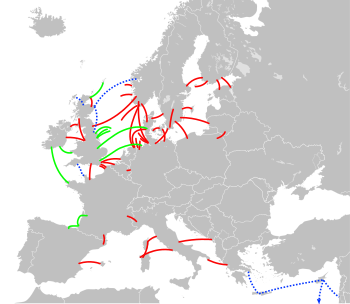
Back تيار الجهد العالي المستمر Arabic Corrent continu d'alta tensió Catalan HVDC Czech HVDC Danish Hochspannungs-Gleichstrom-Übertragung German Συνεχές ρεύμα υψηλής τάσης Greek Corriente continua de alta tensión Spanish Alalisvooluühendus Estonian جریان مستقیم ولتاژ بالا Persian Suurjännitetasavirta Finnish

A high-voltage direct current (HVDC) electric power transmission system uses direct current (DC) for electric power transmission, in contrast with the more common alternating current (AC) transmission systems.[1]
Most HVDC links use voltages between 100 kV and 800 kV. However, a 1,100 kV link in China was completed in 2019 over a distance of 3,300 km (2,100 mi) with a power capacity of 12 GW.[2][3] With this dimension, intercontinental connections become possible which could help to deal with the fluctuations of wind power and photovoltaics.[4]
HVDC lines are commonly used for long-distance power transmission, since they require fewer conductors and incur less power loss than equivalent AC lines. HVDC also allows power transmission between AC transmission systems that are not synchronized. Since the power flow through an HVDC link can be controlled independently of the phase angle between source and load, it can stabilize a network against disturbances due to rapid changes in power. HVDC also allows the transfer of power between grid systems running at different frequencies, such as 50 and 60 Hz. This improves the stability and economy of each grid, by allowing the exchange of power between previously incompatible networks.
The modern form of HVDC transmission uses technology developed extensively in the 1930s in Sweden (ASEA) and in Germany. Early commercial installations included one in the Soviet Union in 1951 between Moscow and Kashira, and a 100 kV, 20 MW system between Gotland and mainland Sweden in 1954.[5] Before the Chinese project of 2019, the longest HVDC link in the world was the Rio Madeira link in Brazil, which consists of two bipoles of ±600 kV, 3150 MW each, connecting Porto Velho in the state of Rondônia to the São Paulo area with a length of more than 2,500 km (1,600 mi).[6]

- ^ Arrillaga, Jos; High Voltage Direct Current Transmission, second edition, Institution of Electrical Engineers, ISBN 0 85296 941 4, 1998.
- ^ "Changji-Guquan ±1,100 kV UHV DC Transmission Project Starts Power Transmission". SGCC. Archived from the original on 27 January 2020. Retrieved 26 January 2020.
- ^ "ABB wins orders of over $300 million for world's first 1,100 kV UHVDC power link in China". abb.com. 2016-07-19. Retrieved 2017-03-13.
- ^ "The Future of Power Is Transcontinental, Submarine Supergrids". Bloomberg.com. 2021-06-09. Retrieved 2021-09-06.
- ^ Hingorani, N.G. (1996). "High-voltage DC transmission: a power electronics workhorse". IEEE Spectrum. 33 (4): 63–72. doi:10.1109/6.486634.
- ^ ABB HVDC Archived 2011-12-06 at the Wayback Machine website.
© MMXXIII Rich X Search. We shall prevail. All rights reserved. Rich X Search